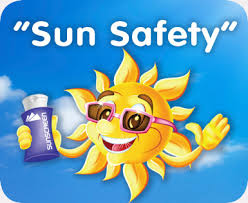It’s natural to want to get out in the sun when the days get longer and the temperature gets warmer. It’s also a good time to review the latest expert advice about how to protect your skin from damage.
Ultraviolet (UV) rays – from the sun and other sources like tanning beds – are the primary cause of skin cancer. Too much exposure can also cause sunburn, eye damage and premature wrinkles. But shielding your skin with clothing, broad-spectrum sunscreen of sun protection factor (SPF) 30 or higher, and staying in the shade can help lower your risk.
 Take these steps to stay sun-safe:
Take these steps to stay sun-safe:
- Cover up: When you are out in the sun, wear clothing and a wide-brimmed hat to protect as much skin as possible. Protect your eyes with sunglasses that block at least 99% of UV light.
- Use a broad spectrum sunscreen with SPF of at least 30: Be sure to reapply at least every 2 hours, as well as after swimming or sweating.
- Seek shade: Limit your direct exposure to the sun, especially between the hours of 10 a.m. and 4 p.m., when UV rays are strongest.
- Avoid tanning beds and sunlamps: Both can cause serious long-term skin damage and contribute to skin cancer.
Choosing the right sunscreen
While you should use sunscreen every day of the year, it’s even more important during summertime, when the days are longer, the sun is stronger, and it’s easier to spend more time outdoors. When choosing sunscreen, be sure to read the label before you buy. US Food and Drug Administration regulations that went into effect in 2012 require the labels to follow certain guidelines. Our guide can help you understand the terminology.
- Choose a sunscreen with “broad spectrum” protection. Sunscreens with this label protect against both UVA and UVB rays. All sunscreen products protect against UVB rays, which are the main cause of sunburn. But UVA rays also contribute to skin cancer and premature aging. Only products that pass a test can be labeled “broad spectrum.” Products that aren’t broad spectrum must carry a warning that they only protect against sunburn, not skin cancer or skin aging.
- Make sure your sunscreen has a sun protection factor (SPF) 30 or higher. The SPF number is the level of protection the sunscreen provides against UVB rays. Higher SPF numbers do mean more protection, but the higher you go, the smaller the difference becomes. SPF 15 sunscreens filter out about 93% of UVB rays, while SPF 30 sunscreens filter out about 97%, SPF 50 sunscreens about 98%, and SPF 100 about 99%. No sunscreen protects you completely. The FDA requires any sunscreen with SPF below 15 to carry a warning that it only protects against sunburn, not skin cancer or skin aging.
- “Water resistant” does not mean “waterproof.” No sunscreens are waterproof or “sweatproof,” and manufacturers are no longer allowed to claim that they are. If a product’s front label makes claims of being water resistant, it must specify whether it lasts for 40 minutes or 80 minutes while swimming or sweating. For best results, reapply sunscreen at least every 2 hours and even more often if you are swimming or sweating. Sunscreen usually rubs off when you towel yourself dry, so you will need to put more on.
